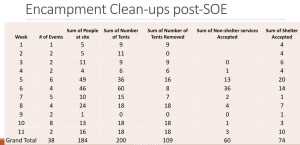Leading With a Public Health Response For Those Without Shelter
I’ve been hearing a variety of concerns about how the city is removing homeless encampments. We are hoping to mitigate the harm this displacement is causing and discuss how we can take a more mindful, transparent, public-health oriented approach.
People experiencing homelessness themselves as well as their advocates have been sharing their frustrations over the last several weeks. In a November letter, the ACLU, Columbia Legal Services, and the Seattle King County Coalition on Homelessness stated that the ‘City’s practices appear to include referring people from encampments to shelters that are already at capacity, effectively displacing people who are already in shelter or waiting in line for shelter, and forcing those indoors back into the streets.’ The Public Defender Association sent a letter today as well.
Since the November 2nd declaration of emergency, more than 200 shelter beds have been added to the system; this is good news. However, I am concerned this is insufficient to meet the very real emergency survival needs of the people our encampment removal practices displace. For that reason, as well as concerns about the destruction of personal belongings thought to be garbage I asked Deputy Mayor Kate Joncas, together with the Departments who lead these efforts, the Human Services Department and the Financial and Administrative Services Departments, to come and brief the Council about those efforts.
I appreciate the Executive Department’s response to Council’s concerns and sharing the procedures used to address issues related to outdoor camping today. I am looking forward to February 1, when we’ll learn more about how the Mayor proposes to spend funds allocated during the 2016 budget process, including $2,265,000 to create an Emergency Homeless Program for 2016, as well as a spending plan for both the $2,265,000, and the $5 million proposed by the Mayor as part of the declaration of a State of Emergency and added to the budget by Ordinance 124892 in November 2015. Thanks as well are extended to the Council’s Human Services and Public Health Chair Sally Bagshaw for her commitment to continue this discussion in her upcoming February 10, committee meeting.
In today’s Briefing we learned that 38 encampments with approximately 184 people staying in them were removed since early November. Of those 184 people, only 74 received shelter. I appreciated Councilmember Burgess’ request for more information about why only 74 people received shelter – was the capacity insufficient? Did people refuse shelter, and if so, why? The Council was also told about the development of the 2008 encampment removal protocols. Bill Hallerman of Catholic Community Services reminded Councilmembers that development of that 2008 policy included a public process. Several Councilmembers today requested that the Executive consider a new public process to review the existing protocols.
I support that request, but in the interim, my request of the Executive is that of the approximately 171 encampment sites identified, that the Council and the public receive information about the number of the locations that are deemed to be priorities for removal because of public safety threats to residents and/or surrounding communities. I would like that information to be shared as soon as possible in the hopes we can quickly find some common ground around how best to address the safety of the people there. For those sites that are not priorities for removal, I would request that we consider using this discussion to design a new public health approach to outreach to those individuals, rather than using limited resources that may only displace people to even less safe locations.
I remain concerned about the resources that we have for the people staying in encampments that have already been removed. Of the approximately 184 people staying in the 38 encampments removed since early November, only 74 received shelter. We need to know more about whether the approximately 110 people who didn’t receive shelter were offered it and refused, and if so why, and whether there wasn’t sufficient capacity so that we can address these needs using the authority granted the Mayor under the State of Emergency. Other Councilmembers (O’Brien and Gonzalez) expressed concerns about the process used to determine whether property was waste or of value and in what languages that information is conveyed.
You can watch the meeting here.
More on the Homelessness State of Emergency/District 1 Edition
Another announced we learned of today that I know will interest District 1 members is that the Mayor has a plan for 2 safe parking lots for people currently living in their vehicles. This proposal includes an Emergency Order. One of the two proposed sites is the Glassyard WSDOT property on East Marginal Way. I understand this will not be a functioning site for 30 days and is proposed to include a community-based organization to manage the lot, as well as a code of conduct, trash removal, porta-potties, and social service provision to the residents. I’ll provide more information soon and have requested that Executive staff attend community meetings in Delridge and Highland Park over the next week.
Posted: January 19th, 2016 under Councilmember Herbold, Homelessness, Proclamations, Public Health, Transportation
Tags: homelessness, Housing


